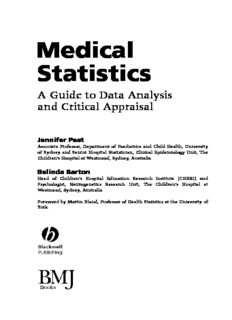
Medical Statistics A Guide to Data Analysis and Critical Appraisal Jennifer Peat Associate ... PDF
Preview Medical Statistics A Guide to Data Analysis and Critical Appraisal Jennifer Peat Associate ...
Medical Statistics A Guide to Data Analysis and Critical Appraisal Jennifer Peat Associate Professor, Department of Paediatrics and Child Health, University of Sydney and Senior Hospital Statistician, Clinical Epidemiology Unit, The Children’sHospitalatWestmead,Sydney,Australia Belinda Barton Head of Children’s Hospital Education Research Institute (CHERI) and Psychologist, Neurogenetics Research Unit, The Children’s Hospital at Westmead,Sydney,Australia ForewordbyMartinBland,ProfessorofHealthStatisticsattheUniversityof York Medical Statistics A Guide to Data Analysis and Critical Appraisal Medical Statistics A Guide to Data Analysis and Critical Appraisal Jennifer Peat Associate Professor, Department of Paediatrics and Child Health, University of Sydney and Senior Hospital Statistician, Clinical Epidemiology Unit, The Children’sHospitalatWestmead,Sydney,Australia Belinda Barton Head of Children’s Hospital Education Research Institute (CHERI) and Psychologist, Neurogenetics Research Unit, The Children’s Hospital at Westmead,Sydney,Australia ForewordbyMartinBland,ProfessorofHealthStatisticsattheUniversityof York (cid:2)C 2005byBlackwellPublishingLtd BMJBooksisanimprintoftheBMJPublishingGroupLimited,usedunderlicence BlackwellPublishingInc.,350MainStreet,Malden,Massachusetts02148-5020,USA BlackwellPublishingLtd,9600GarsingtonRoad,OxfordOX42DQ,UK BlackwellPublishingAsiaPtyLtd,550SwanstonStreet,Carlton,Victoria3053,Australia TherightoftheAuthortobeidentifiedastheAuthorofthisWorkhasbeenassertedin accordancewiththeCopyright,DesignsandPatentsAct1988. Allrightsreserved.Nopartofthispublicationmaybereproduced,storedinaretrieval system,ortransmitted,inanyformorbyanymeans,electronic,mechanical,photo- copying,recordingorotherwise,exceptaspermittedbytheUKCopyright,Designs andPatentsAct1988,withoutthepriorpermissionofthepublisher. Firstedition2005 LibraryofCongressCataloging-in-PublicationData Peat,JenniferK. Medicalstatistics:aguidetodataanalysisandcriticalappraisal/byJennifer PeatandBelindaBarton.–1sted. p.;cm. Includesbibliographicalreferencesandindex. ISBN-13:978-0-7279-1812-3 ISBN-10:0-7279-1812-5 1.Medicalstatistics. 2.Medicine–Research–Statisticalmethods. I.Barton,Belinda.II.Title. [DNLM:1.Statistics–methods. 2.ResearchDesign. WA950P363m2005] R853.S7P432005 610(cid:3).72(cid:3)7–dc22 2005000168 AcataloguerecordforthistitleisavailablefromtheBritishLibrary Setin9.5/12ptMeridien&FrutigerbyTechBooks,NewDelhi,India PrintedandboundinHarayana,IndiabyReplikaPressPvtLtd CommissioningEditor:MaryBanks EditorialAssistant:MirjanaMisina DevelopmentEditor:VeronicaPock ProductionController:DebbieWyer ForfurtherinformationonBlackwellPublishing,visitourwebsite: http://www.blackwellpublishing.com Thepublisher’spolicyistousepermanentpaperfrommillsthatoperateasustainable forestrypolicy,andwhichhasbeenmanufacturedfrompulpprocessedusingacid-free andelementarychlorine-freepractices.Furthermore,thepublisherensuresthatthetext paperandcoverboardusedhavemetacceptableenvironmentalaccreditationstandards. Contents Foreword,vii Acknowledgements,ix Chapter1 Datamanagement:preparingtoanalysethedata,1 Chapter2 Continuousvariables:descriptivestatistics,24 Chapter3 Continuousvariables:comparingtwoindependentsamples,51 Chapter4 Continuousvariables:pairedandone-samplet-tests,86 Chapter5 Continuousvariables:analysisofvariance,108 Chapter6 Continuousdataanalyses:correlationandregression,156 Chapter7 Categoricalvariables:ratesandproportions,202 Chapter8 Categoricalvariables:riskstatistics,241 Chapter9 Categoricalandcontinuousvariables:testsofagreement,267 Chapter10 Categoricalandcontinuousvariables:diagnosticstatistics,278 Chapter11 Categoricalandcontinuousvariables:survivalanalyses,296 Glossary,307 Index,317 v Foreword Most research in health care is not done by professional researchers, but by health-care practitioners. This is very unusual; agricultural research is not done by farmers, and building research is not done by bricklayers. I am told that it is positively frowned upon for social workers to carry out research, whentheycouldbesolvingtheproblemsoftheirclients.Practitioner-ledre- searchcomesabout,inpart,becauseonlyclinicians,ofwhateverprofessional background, have access to the essential research material, patients. But it also derives from a long tradition, in medicine for example, that it is part of theroleofthedoctortoaddtomedicalknowledge.Itisimpossibletosucceed in many branches of medicine without a few publications in medical jour- nals.Thistraditionisnotconfinedtomedicine.LetusnotforgetthatFlorence Nightingalewasknownas‘thePassionateStatistician’andhergreatestinno- vationwasthatshecollecteddatatoevaluatehernursingpractice.(Shewas the first woman to become a fellow of the Royal Statistical Society and is a heroinetoallthinkingmedicalstatisticians.) Thereareadvantagestothissystem,especiallyforevidence-basedpractice. Clinicians often have direct experience of research as participants and are aware of some of its potential and limitations. They can claim ownership of theevidencetheyareexpectedtoapply.Thedisadvantageisthathealth-care researchisoftendonebypeoplewhohavelittletraininginhowtodoitand who have to do their research while, at the same time, carrying on a busy clinical practice. Even worse, research is often a rite of passage: the young researchercarriesoutoneortwoprojectsandthenmovesonanddoesnotdo researchagain.Thusthereisacontinualstreamofnewresearchers,needing tolearnquicklyhowtodoit,yetthereisashortageofseniorresearchersto actasmentors.Andresearchisnoteasy.Whenwedoapieceofresearch,we are doing something no one has done before. The potential for the explorer tomakeajourneywhichleadsnowhereisgreat. The result of practitioner-led research is that much of it is of poor quality, potentiallyleadingtofalseconclusionsandsub-optimaladviceandtreatment for patients. People can die. It is also extremely wasteful of the resources of institutions which employ the researchers and their patients. From the researchers’pointofview,readingthepublishedliteratureisdifficultbecause thefindingsofotherscannotbetakenatfacevalueandeachpapermustbe read critically and in detail. Their own papers are often rejected and even oncepublishedtheyareopentocriticismbecausethemostcarefulrefereeing procedureswillnotcorrectalltheerrors. Whenresearchersbegintoreadtheresearchliteratureintheirchosenfield, one of the first things they will discover is that knowledge of statistics is vii viii Foreword essential. There is no skill more ubiquitous in health-care research. Several ofmyformermedicalstudentshavecometomeforabitofstatisticaladvice, tellingmehowtheynowwishedtheyhadlistenedmorewhenItaughtthem. Well, I wish they had, too, but it would not have been enough. Statistical knowledgeisveryhardtogain;indeed,itisoneofthehardestsubjectsthere is, but it is also very hard to retain. Why is it that I can remember the lyrics (though not, my family assures me, the tunes) of hundreds of pop songs of myyouth,butnotthedetailsofanystatisticalmethodIhavenotappliedin thelastmonth?AndIspendmuchofmytimeanalysingdata. What the researchers need is a statistician at their elbow, ready to answer any questions that arise as they design their studies and analyse their data. Theyaresohardtofind.Evenoneconsultationwithastatistician,ifitcanbe obtainedatall,mayinvolveawaitforweeks.Ithinkthatthemostefficientway toimprovehealth-careresearchwouldbetotrainandemploy,preferablyat highsalaries,largenumbersofstatisticianstoactascollaborators.(Incidentally, statisticians should make the ideal collaborators, because they will not care about the research question, only about how to answer it, so there is no risk of them stealing the researcher’s thunder.) Until that happy day dawns, statisticalsupportwillremainashardtofindasanhonestpolitician.Thisbook providesthenextbestthing. The authors have great experience of research collaboration and support forresearchers.JennyPeatisastatisticianwhohasco-authoredmorethana hundredhealthresearchpapers.Shedescribesherselfasa‘researchtherapist’, always ready to treat the ailing project and restore it to publishable health. Belinda Barton brings the researcher’s perspective, coming into health re- searchfromabackgroundinpsychology.Theirpracticalexperiencefillsthese pages. The authors guide the reader through all the methods of statistical analysis commonly found in the health-care literature. They emphasise the practicaldetailsofcalculation,givingdetailedguidanceastothecomputation of the methods they describe using the popular program SPSS. They rightly stresstheimportanceoftheassumptionsofmethods,includingthosewhich statisticiansoftenforgettomention,suchastheindependenceofobservations. Researcherswhofollowtheiradviceshouldnotbetoldbystatisticalreferees thattheiranalysesareinvalid.PeatandBartoncloseeachchapterwithalistof thingstowatchoutforwhenreadingpaperswhichreportanalysisusingthe methodstheyhavejustdescribed.Researcherswillalsofindtheseinvaluable ascheckliststousewhenreadingovertheirownwork. I recently remarked that my aim for my future career is to improve the quality of health-care research. ‘What, worldwide?’, I was asked. Of course, whylimitourselves?Ithinkthatthisbook,comingfromtheothersideofthe worldfromme,willhelpbringthattargetsomuchcloser. MartinBland, ProfessorofHealthStatistics,UniversityofYork, August2004
Description: